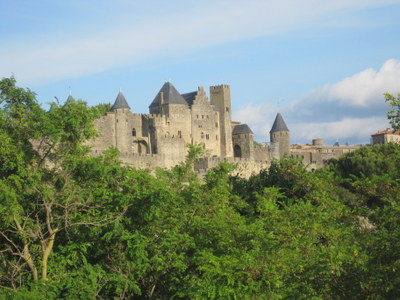
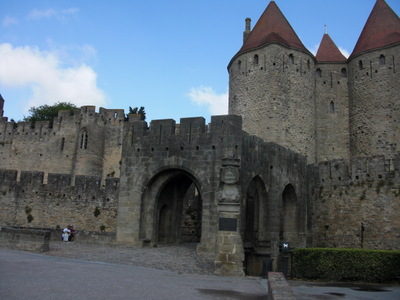 We allowed plenty of time for the hike up the hill to the cité, where our tour would begin at the other Office de Tourisme, which is located inside one of the circular towers just inside the city's main gate.
We allowed plenty of time for the hike up the hill to the cité, where our tour would begin at the other Office de Tourisme, which is located inside one of the circular towers just inside the city's main gate. Sunday, 1 June 2014: Carcassonne, by land and by sea (well, by canal)
Written 12 June
In the morning, as promised by the huge banners strung across the streets, the Bread Festival was under way in the Square Gambetta, together with the big rummage sale that was to accompany it. Our tour started at 10 a.m. up in the cité, so we didn't take the time to walk all the way to the far end of the square, but we could see in the distance the bread booths, in which bakers were already kneading big lumps of dough. The rummage sellers were still setting up, but we took a short turn to see what sorts of things they had. As usual, they seemed to be a mixture of genuine rummage—individuals selling off old baby clothes and other garage-saley sorts of things—and professional junk dealers, who travel from sale to sale in vans with their stock.

 We allowed plenty of time for the hike up the hill to the cité, where our tour would begin at the other Office de Tourisme, which is located inside one of the circular towers just inside the city's main gate.
We allowed plenty of time for the hike up the hill to the cité, where our tour would begin at the other Office de Tourisme, which is located inside one of the circular towers just inside the city's main gate.
David got this shot of the city walls on the way up the hill. On the way, we were able to scope out the parking arrangements. Our restaurant for the evening is right in the middle of the cité, where parking was clearly out of the question. I had queried the restaurant (which is in a hotel) by e-mail about whether we, as restaurant patrons, could use the parking lot reserved for guests of cité hotels, but I hadn't heard back yet. Fortunately, we were able to see that several large parking lots near the top are available to the public (so when the restaurant replied later in the negative, it wasn't a serious problem).
At the right is the outer gate, that is, the gate in the outer of the two walls that surround the whole cité. As the guide later pointed out, it is equipped with not one but two portcullises, each with holes through which heavy objects and/or arrows could be rained down on attackers, and even providing the possibility of trapping attackers between the two.
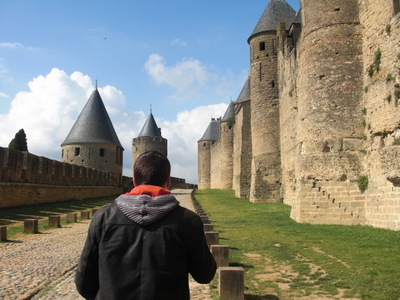
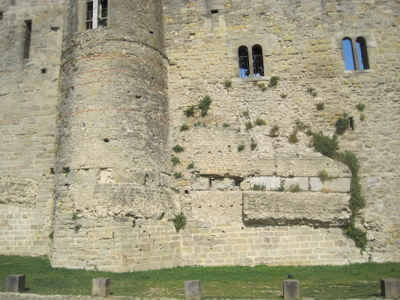 Only four of us signed up for the tour (David and me plus one French couple), and Julien, our guide, was great. He started by taking us out into the "lices," the space between the inner and outer walls (a handy place in which to hold jousting matches as well as a murderous zone for attackers from outside to try to cross) to show us details of the wall construction.
Only four of us signed up for the tour (David and me plus one French couple), and Julien, our guide, was great. He started by taking us out into the "lices," the space between the inner and outer walls (a handy place in which to hold jousting matches as well as a murderous zone for attackers from outside to try to cross) to show us details of the wall construction.
The site has been fortified since the days when the Celtic Gauls had a wooden stockade there, because it's (a) highly defensible and (b) extremely strategic, dominating both the river and the relatively narrow area between two mountain ranges, a trade and travel bottleneck. Only when the Romans showed up was the stone inner wall built; in the photo at the left, you can see, starting about halfway up, the horizontal courses of brick interspersed with the stone characteristic of Roman fortifications. Later, in the middle ages, the outer wall was added, and the builders wanted to level the area between the two walls. They therefore excavated along the inner wall and moved the dirt toward the outer wall. The course of very large stones visible about 1/3 of the way up is the actual foundation of the Roman wall, the base on which the rest was built, so as they dug further and further down, they had to insert stones under that foundation, building the wall downward as they went, to support the parts above!
Later still, when the walls were no longer needed for defense, people built houses in the lices, up against the walls. You can see rows of holes drilled into the stone to support the ends of beams and joists and (in the case of the diagonal row down the side of the tower) a staircase.
In fact, the amazing preservation of the cité is due in large part to the general migration of all parts of the population that could afford it down the hill to the more spacious and comfortable bastide. Once Carcassonne was no longer on a national border and no longer in danger of attack, no one was tempted to tear down the walls for expansion's sake because it already filled the whole hilltop. Instead, they just abandonned it and moved down to the flats (except the poor ones, who built those wooden houses in the lices). Much of it fell into ruin over the centuries, but once its historic value was recognized, Viollet-le-Duc was brought in to restore it (don't get me started on Viollet-le-Duc, the architectural Walt Disney of his time, but I have to admit that he did a pretty good job on this one).
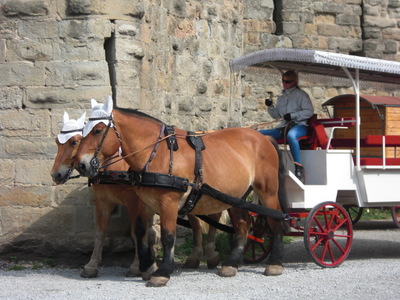
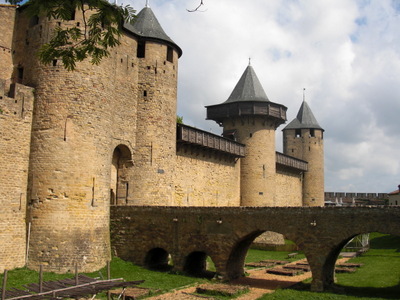 If a walking tour doesn't appeal to you, you can instead tour the old city by horse-drawn "caleche," but I doubt the narration is as informative as what we got from Julien.
If a walking tour doesn't appeal to you, you can instead tour the old city by horse-drawn "caleche," but I doubt the narration is as informative as what we got from Julien.
Written 13 June
At the right is the bridge that leads from the streets of the citéinto the castle, a fortress-within-a-fortress that served as the residence of whatever lord was in charge of the place at the time. That required a separate admission charge and tour, which we didn't go for.
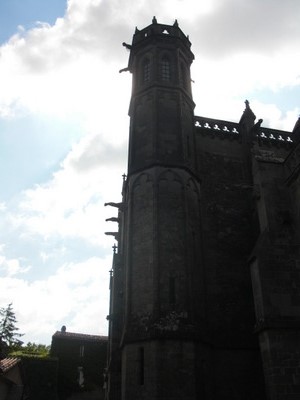
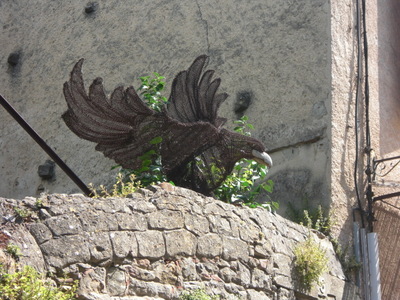 At the left here is the tower of the basilica (once a cathedral but now no longer the seat of a bishop), complete with gargoyles. Because it was Sunday, mass was in session when we got there, so we couldn't go in.
At the left here is the tower of the basilica (once a cathedral but now no longer the seat of a bishop), complete with gargoyles. Because it was Sunday, mass was in session when we got there, so we couldn't go in.
At the right is a wonderful decorative raven (or jackdaw?), maybe 2 or 3 feet across, that someone had perched on his garden wall (about 50 people still live in the cité full time). It looked like wicker, but it might have been painted metal or something else more durable. Julien mentioned that the cité still has permanent residents, about 50, I think he said.
This tour was very different from the one we had in 1993, when we visited the city for a morning as part of the meiofauna congress's midmeeting outing. That one included indoor visits to several of the towers (one of which was fiendishly constructed so that its interior stone spiral stairway, entirely without handrail of any kind, spiraled the wrong way, that is, the opposite of the customary orientation; the idea was that locals fleeing down that stairway knew the trick, whereas the attackers pursuing them would up taking a header down the tower's open center well) and a walk along the ramparts, whereas this one was all outdoors. Perhaps what we got then was the castle tour rather than the city tour. On that trip, the bus just whisked us by the lower city (on the way to the afternoon's drive-by viewings of several Cathar castles), which we had no idea then had any historical interest of its own.
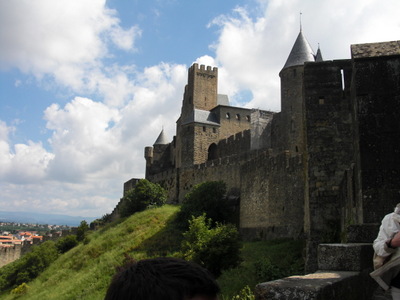
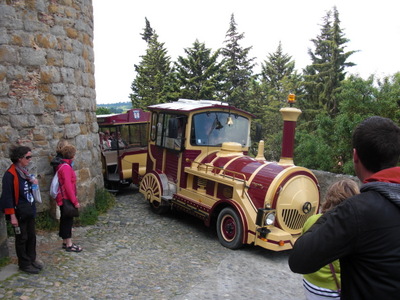 After we'd covered the major points of interest in the cité, Julien took us out through the Porte de l'Aude (the gate we came in was the Porte de Narbonne, because it faces Narbonne, of course, which is still usable by motor vehicles; the Porte de l'Aude faces the Aude River and is for pedestrians only), where we got another good shot of the ramparts on the side facing the river and, on the other side, the lower city. The square tower is part of the castle.
After we'd covered the major points of interest in the cité, Julien took us out through the Porte de l'Aude (the gate we came in was the Porte de Narbonne, because it faces Narbonne, of course, which is still usable by motor vehicles; the Porte de l'Aude faces the Aude River and is for pedestrians only), where we got another good shot of the ramparts on the side facing the river and, on the other side, the lower city. The square tower is part of the castle.
We had to stand aside briefly at that point to allow the little tourist train to pass. I remarked on its complete failure to be white, so Julien explained that Carcassonne has two, which are different colors to avoid confusion. This one operates only in the cité, venturing out through the gates just for the view of the ramparts, then back in again. The other, which is white, shuttles continuously between the cité and the bastide, and, unusually, on that one you can buy a one-way ticket and actually use it for transportation up and down the hill, rather than just riding the whole circuit back to the starting point—very useful for those who find climbing the hill on foot daunting. I think the shuttle train runs only in the summer; anyway, it had started by the time we were there, because it happened to pass us at one point later in the day.
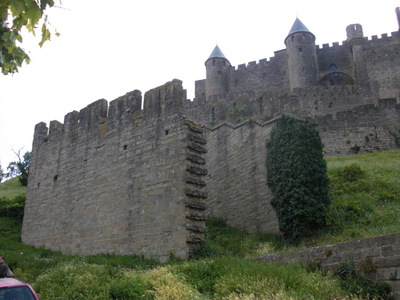
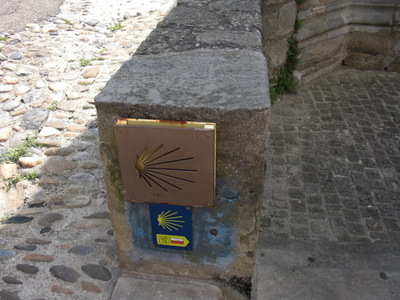 Most of the way down the hill, Julien stopped to show us the truncated end of this walled corridor that comes down from the cité to a point near the river. The wells at the top of the hill were not adequate to supply the cité, particularly in times of siege, so the defenders relied on a deep well down by the river and ran a walled path down to its walled enclosure—definitely a weak link in the defenses, I'd say. The lower end of the walled path was truncated at some later date to make way for construction of another church.
Most of the way down the hill, Julien stopped to show us the truncated end of this walled corridor that comes down from the cité to a point near the river. The wells at the top of the hill were not adequate to supply the cité, particularly in times of siege, so the defenders relied on a deep well down by the river and ran a walled path down to its walled enclosure—definitely a weak link in the defenses, I'd say. The lower end of the walled path was truncated at some later date to make way for construction of another church.
The tour then led down the hill and over the 14th century Pont Vieux to the Bastide St. Louis. At the bastide end of the bridge, I paused to get this shot of a stylized scallop shell, marking this as part of the pathway to Santiago da Compostella.
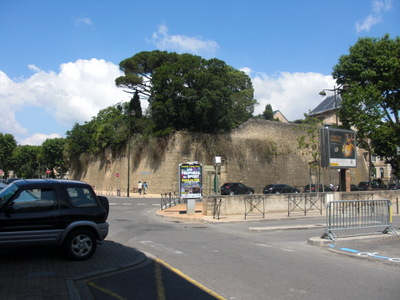
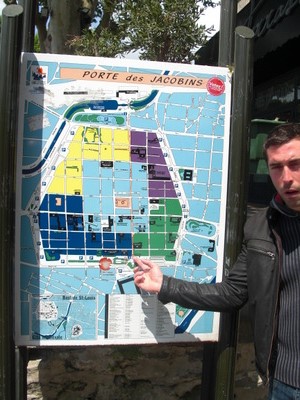 Rather than taking us by the shortest route to the bastide, through the Square Gambetta, where the bastide boundary is marked only by a wide road where the walls used to be, Julien took us to the southeast corner of it (shown at the left), then in through the Porte des Jacobins (where he's pointing on the map), where the walls still stand. They were built in the early 16th century, just about the time metal cannonballs came into use, so rather than being solid stone, like those of the cité, they consist of inner and outer stone facings and a thick filling of rubble, the better to absorb the cannonballs.
Rather than taking us by the shortest route to the bastide, through the Square Gambetta, where the bastide boundary is marked only by a wide road where the walls used to be, Julien took us to the southeast corner of it (shown at the left), then in through the Porte des Jacobins (where he's pointing on the map), where the walls still stand. They were built in the early 16th century, just about the time metal cannonballs came into use, so rather than being solid stone, like those of the cité, they consist of inner and outer stone facings and a thick filling of rubble, the better to absorb the cannonballs.
As he pointed out during our stroll through the bastide, not much is visible on the outside. The houses were built during a time when the fashion was to turn a very plain façade to the street and to hide all signs of wealth inside. Apparently many of the houses shelter treasures of Medieval art and architecture that you get no hint of from the sidewalk.
The heart of the lower city is the Place Carnot (in beigey pink in the center of the map). We walked through it several times during our stay, and it was always full of café umbrellas. The Square Gambetta is the green streaked oblong above Julien's forearm (our hotel is at the lower right corner of it), and the cité is about where his right lung is.
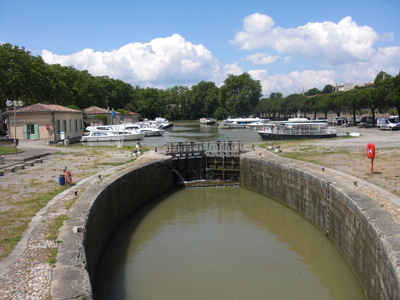
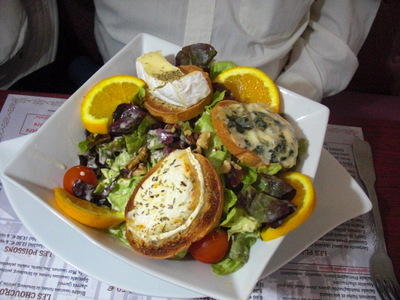 The tour ended when we reached the Carcassonne boat basin on the Canal du Midi (the wide part of in the canal as it snakes around the northwest corner of the bastide). The other couple on the tour live in Cahors and own a live-aboard boat; they had arrived in Carcassonne by sailing (well, motoring) up the canal from the Mediterranean, and their boat was moored right there in the boat basin (just beyond the lock in the right-hand photo below). While we went off in search of lunch, they invited Julien aboard for a drink!
The tour ended when we reached the Carcassonne boat basin on the Canal du Midi (the wide part of in the canal as it snakes around the northwest corner of the bastide). The other couple on the tour live in Cahors and own a live-aboard boat; they had arrived in Carcassonne by sailing (well, motoring) up the canal from the Mediterranean, and their boat was moored right there in the boat basin (just beyond the lock in the right-hand photo below). While we went off in search of lunch, they invited Julien aboard for a drink!
We found what we were looking for at a place that called itself "Le Bistro." The little antique enamel plaques bearing its table numbers all read "Le Bistro d'Augustin," but the management had apparently decided that wasn't trendy enough. David ordered the "Cheesemaker's salad," which included Camembert, a blue, and a goat cheese, all grilled on toast. Keep in mind that this is the appetizer portion. For 4 euros more, he could have had the "giant" portion.
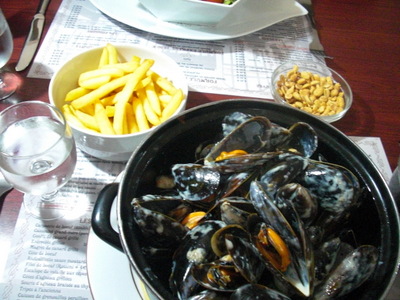
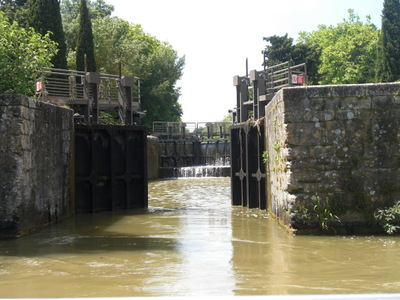 I grabbed the chance to have mussels again, this time cooked with cream. That's what I got—mussels cooked with cream—no garlic, no white wine, no shallots, just cream. Pretty good, though.
I grabbed the chance to have mussels again, this time cooked with cream. That's what I got—mussels cooked with cream—no garlic, no white wine, no shallots, just cream. Pretty good, though.
At the canal, we found two companies (on opposite sides of the basin) advertising 2-hour cruises. We were already booked for a cruise from a different location the following day, but what the heck, we'd been walking all morning; let's cruise this afternoon. So we signed up and trooped aboard. The excursion we signed up for was actually 2.5 hours, because it included a stop on the way back at a place where you could get a soft drink or cup of tea.
The cruise was lovely (our boat is hidden behind the one on the right just beyond the lock in the photo above, to the right of the salad). We passed at leisurely pace (speed limit on the canal is 4 mph) through two locks and saw myriad wildflowers. The guide named off lots of water birds we might see, but what we did see was mostly mallards, some with tiny baby ducklings.
On our cruise some years ago on the Canal Latérale de la Marne, the locks were automatic; the barge pilot operated a switch hanging down from a cable across the canal as we approached each lock. The locks on this canal are still manned (or, at least on this day, womaned), although the keepers no longer live in the little houses on the banks that were intended for them. They wear little switch boxes on shoulder straps and operate the doors (wirelessly) by twiddling little switches and joysticks on the boxes.
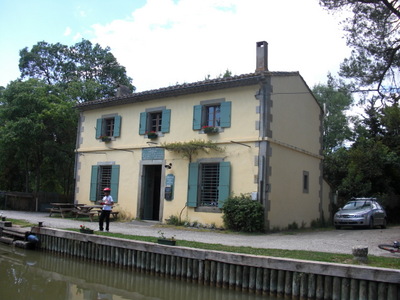
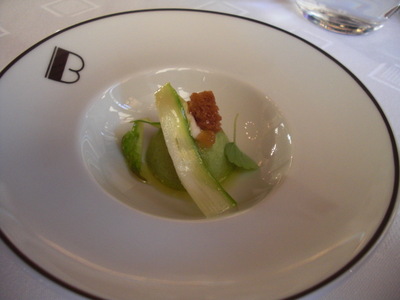 Our stop was at the Épanchoir de Foucaud, an overflow valve that prevents the canal from coming up over its banks in time of heavy rain. A special sluicegate (épanchoir) is opened that lets the excess water run out along a smaller canal built for the purpose and down into the river. This building is not a lock-keeper's house but looks just like one; it housed the épanchoir-keeper only at times when flooding threatened. Like the lock-keepers houses, it bears a little placque above the door that gives the name of the place, the names of the nearest upstream and downstream locks, and the distances to them in meters.
Our stop was at the Épanchoir de Foucaud, an overflow valve that prevents the canal from coming up over its banks in time of heavy rain. A special sluicegate (épanchoir) is opened that lets the excess water run out along a smaller canal built for the purpose and down into the river. This building is not a lock-keeper's house but looks just like one; it housed the épanchoir-keeper only at times when flooding threatened. Like the lock-keepers houses, it bears a little placque above the door that gives the name of the place, the names of the nearest upstream and downstream locks, and the distances to them in meters.
During the stop, we fell into conversation with a nice British couple who now live full time on their boat on the canal (it was moored a few steps away). That is, he lives there full time; she commutes back to England to spend time with grandchildren. In the summer, they hang around the Carcassonne area, but in the winter, they drift south and spend their time in the region of the Camargue, where it's warmer. The husband gave us a useful for our next visit to the U.K. He recommended that we seek out Weatherspoon pubs, which he says always have the best selection of ales at the best prices!
As the cruise began, we had chuckled over the private boat parked right next to ours, which had a large gas grill mounted on one of its gunwales. When we returned from the cruise and pulled back into the slip, we could smell the grill long before we saw it; its proprietor was roasting whole eggplants—delicious!
Our restaurant for the evening was in the cité but having ascertained that we could indeed park at the top, we didn't bother hiking back up the hill again. We parked just outside the Porte de Narbonne and located the restaurant so easily and quickly (we had walked right by it durin the tour, and most of the crowds had since gone home) that we had time to step next door to the basilica and see the interior we had missed that morning.
The restaurant, La Barbacane (GM two-tocque I think) is in the Hotel de la Cité, a very grand establishment indeed. The first amuse-bouche, not shown, was, for each of us, a little glass of cold carrot and orange juice soup, a tiny sandwich of sprat on rye crisp, and a little shrimp on a stick, fried so crisp that it was crunchy all the way through, topped with a dot of mustard. the orange-carrot soup was especially good.
Second amuse-bouche: a little dome of asparagus custard, asparagus "carpaccio" (i.e., thinly sliced raw asparagus), a lemon sauce, a tiny crouton, and a few salmon eggs. Excellent.
Once again, we were brought a salted butter and a pepper-flavored butter for our bread. Apparently only the very most pretentious restaurants in this region provide butter. Butter was always offered at breakfast, but in all the lunch restaurants and almost all the dinner places, the bread was offered plain, without any butter or even olive oil.
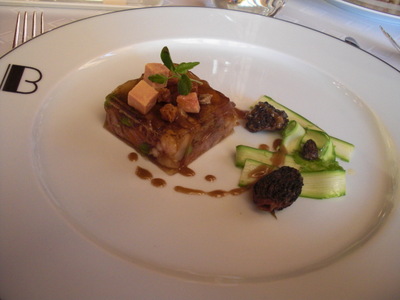
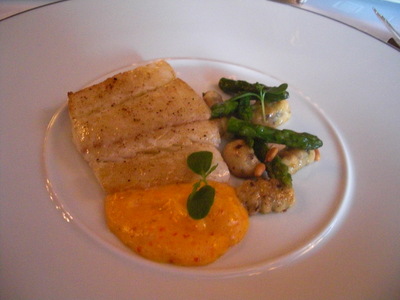 We ordered the "seasonal menu, built around —what else—asparagus and morels, so once again we ate all the same things.
We ordered the "seasonal menu, built around —what else—asparagus and morels, so once again we ate all the same things.
First course: Jellied calf's head topped with little blocks of foie gras, asparagus carpaccio, "morel mustard," and morels marinated in vinaigrette.
Second course: Grilled wild brill (a flatfish), potato gnocchi with morels and pine nuts, asparagus points, and what the menu claimed was a "lemon-vanilla Hollandaise" but looked and tasted more like red bell pepper Hollandaise. Good, anyway.
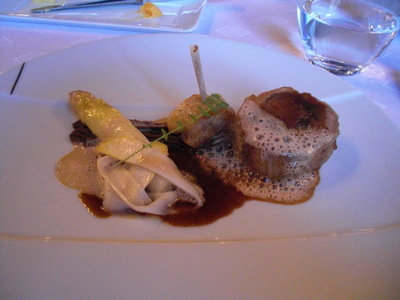
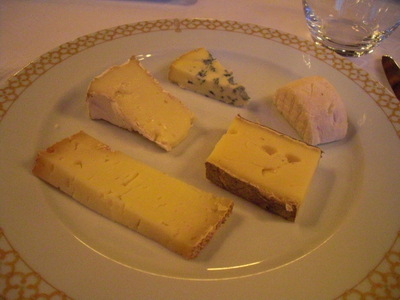 Third course: Bresse chicken "confit" with morel butter, "melting" wing, morels simmered with asparagus (both sliced and whole), a creamy sauce, and a clear sauce. All excellent. The "melting" wing turned out to be a little morel-stuffed chicken piece pierced by a pointed piece of scrupulously clean chicken bone. Excellent; about the best Bresse chicken I've ever had. Restaurants should feature the leg more often; I find chicken breast inherently less interesting/palatable, whatever the provenance of the fowl.
Third course: Bresse chicken "confit" with morel butter, "melting" wing, morels simmered with asparagus (both sliced and whole), a creamy sauce, and a clear sauce. All excellent. The "melting" wing turned out to be a little morel-stuffed chicken piece pierced by a pointed piece of scrupulously clean chicken bone. Excellent; about the best Bresse chicken I've ever had. Restaurants should feature the leg more often; I find chicken breast inherently less interesting/palatable, whatever the provenance of the fowl.
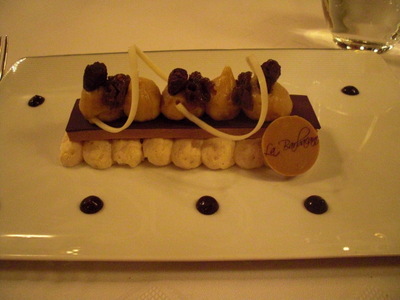
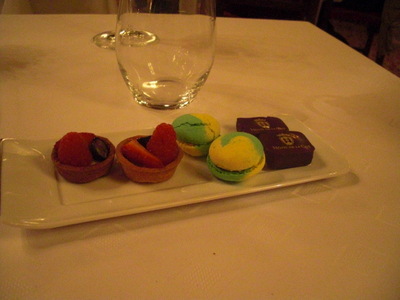
Dessert: "Succès" (i.e., crisp meringue dessert) of "touron" cream ("touron" is a kind of Spanish almond nougat) with chocolate ice cream, tiny chocolate croutons, and yes, morels. The morels seemed a little superfluous to the dessert, but they were an entirely inoffensive addition.
Mignardises: Chocolates with the hotel's name and crest on them, two-tone macaroons (lemon-lime I assume, as I didn't taste them), and tiny strawberry-raspberry-blueberry tarts.
This menu was 85 euros/head, about what we'd expect to pay for this many courses in a much less fancy establishment. In general, we found the dinners less expensive in this region than in many we've visited. (Another bargain was the city of Beaune, which we visited in 2009—diners there get a real break for some reason.)